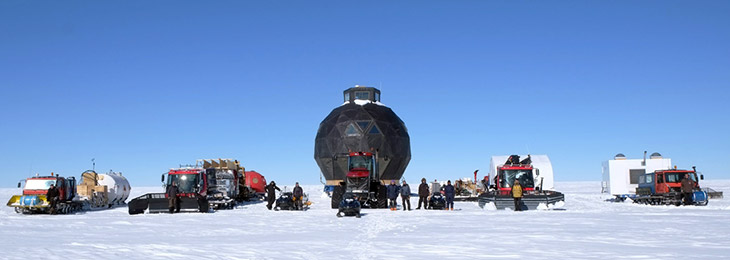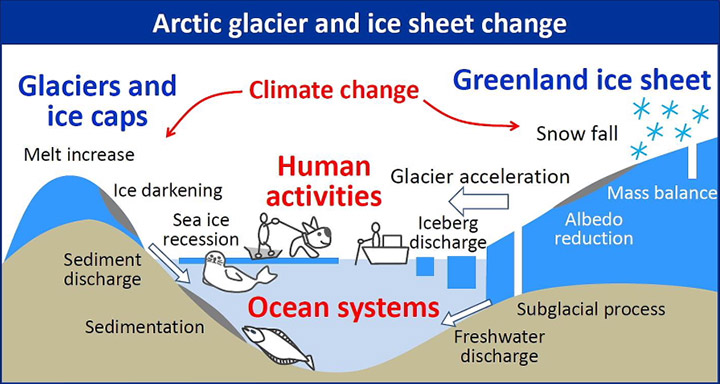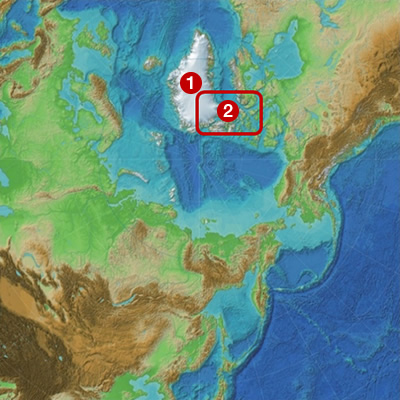Theme 2
Variations in the ice sheet, glaciers, ocean and environment in the Greenland region

PI : Kumiko Goto-Azuma (NIPR)
Study Sites : Greenland ice sheet, Qaanaaq, norhthwestern Greenland
Background of the Research
The Greenland ice sheet and the glaciers, ocean, climate and environment in and around Greenland have been experiencing drastic changes, as has been reported in the IPCC AR5 and the SWIPA reports, and this has been attracting international attention. Mass loss of the Greenland ice sheet could lead not only to sea level rise, but also to abrupt changes in the global climate and ocean circulations, which would influence human societies and economies. However, the mechanisms of these changes and their impacts on climatic and oceanic changes have not been well-understood. The changes occurring in the coastal regions of Greenland have also been affecting the lives of the local communities of Greenland and their cultures, but the details have not been understood. Under these circumstance, we plan to carry out two research items: (1) variability of the Greenland ice sheet and climate, which will focus on Greenland’s interior areas; and (2) ice sheet/glacier-ocean interaction in Greenland, which will focus on the coastal regions of Greenland.
Overview of the Research
Under "Variability of the Greenland ice sheet and climate" research, we participate in the international ice coring project (East Greenland Ice Core Project, EGRIP) and collaborate with Denmark, U.S.A., Norway, France, Switzerland etc. A deep ice core to the bed will be drilled at the onset of the North-East Greenland Ice Stream (NEGIS), where horizontal flow velocity is expected to be several tens of meters per year. As NEGIS is the largest ice stream in Greenland, we expect to advance our knowledge on the dynamics and past changes of the Greenland Ice Sheet through analyses of the EGRIP core, borehole observations and modeling studies. We will reconstruct the climate, environment and ice sheet elevation/extent during the early Holocene, which was considered to be warmer than today and should be an excellent analogue to the future Greenland affected by global warming. We will also study the impacts of warming.
"Ice sheet/glacier - ocean interaction in Greenland" research aims to quantify glacier and ice sheet changes in Greenland, with special attention to ice sheet/glacier-ocean interaction. We also investigate the influence of glacier and ice sheet changes on ocean environments and marine ecosystems. Furthermore, we also study the impact of these changes on human activity in the region. To this end, we perform field and satellite observations, sampling and analyses of snow/ice and sea water, and numerical modeling of the ice sheet/glaciers and the ocean in Greenland. Our focus is on the region in the vicinity of Qaanaaq, which is one of the northernmost villages in northwestern Greenland. The goal of this sub-program is to provide the indigenous people of Qaanaaq with useful information for their activities. Accurate data on changing glaciers and the ocean should help them to adjust their lifestyle to the changing environment.

The East Greenland Ice Core Project (EGRIP) will involve drilling a deep ice core at the head of the Northeast Greenland Ice Stream. Through ice core analyses, bore hole observations and remote sensing studies, ice sheet dynamics and the past climate/ice sheet variability will be studied. The camp was moved from the previous drill site (NEEM) to the new drill site (EGRIP) in May 2015.

Arctic glaciers and the Greenland ice sheet are losing mass under the influence of the changing ocean. In turn, changes in the glaciers are affecting the ocean environment.

Location of Qaanaaq, in northwestern Greenland. In July, the coast of Qaanaaq village is still covered with sea ice.

The diagram illustrates the research targets of "Ice sheet/glacier - ocean interaction in Greenland". We study the interaction of the ice sheet/glaciers and the ocean, and its impact on coastal environments and human activities in the Arctic.
Cooperative Institutions / International Projects
Alfred Wegener Institute for Polar and Marine Research (AWI, Germany), University of Bern (Switzerland), University of Calgary (Canada), Greenland Institute of Natural Resources (GINR, Denmark), University of Copenhagen (Denmark), Swiss Federal Institute of Technology (Swiss), University of Florence (Italy)
East Greenland Ice Core Project (EGRIP)
Implementation Structure
Members
| Name | Institutes |
|---|---|
| Kumiko Goto-Azuma | National Institute of Polar Research |
| Hideaki Motoyama | National Institute of Polar Research |
| Shuji Fujita | National Institute of Polar Research |
| Kenji Kawamura | National Institute of Polar Research |
| Jun'ichi Okuno | National Institute of Polar Research |
| Fumio Nakazawa | National Institute of Polar Research |
| Motohiro Hirabayashi | National Institute of Polar Research |
| Ikumi Oyabu | National Institute of Polar Research |
| Naoko Nagatsuka | National Institute of Polar Research |
| Yuki Komuro | National Institute of Polar Research |
| Tomoyuki Homma | Nagaoka University of Technology |
| Morimasa Takata | Nagaoka University of Technology |
| Nobuhiko Azuma | Nagaoka University of Technology |
| Name | Institutes |
|---|---|
| Shin Sugiyama | Hokkaido University |
| Sumito Matoba | Hokkaido University |
| Yoshinori Iizuka | Hokkaido University |
| Ralf Greve | Hokkaido University |
| Masato Furuya | Hokkaido University |
| Evgeny Podolskiy | Hokkaido University |
| Kazutaka Tateyama | Kitami Institute of Technology |
| Tatsuya Watanabe | Kitami Institute of Technology |
| Naoya Kanna | Hokkaido University |
| Takuto Ando | Hokkaido University |
| Teruo Aoki | National Institute of Polar Research |
Collaborators
| Name | Institutes |
|---|---|
| Wataru Shigeyama | The Graduate University for Advanced Studies |
| Jun Ogata | National Institute of Polar Research |
| Kyotaro Kitamura | National Institute of Polar Research |
| Kaori Fukuda | National Institute of Polar Research |
| Yoshimi Tsukagawa | National Institute of Polar Research |
| Ayako Abe-Ouchi | The University of Tokyo |
| Fuyuki Saito | JAMSTEC |
| Atsushi Furusaki | National Institute of Technology,Asagujawa College |
| Sergio Faria | BC3 |
| Dorthe Dahl-Jensen | University of Copenhagen |
| Ilka Weikusat | Alfred Wegener Institute |
| Hubertus Fischer | University of Bern |
| Paul Vallelonga | University of Copenhagen |
| Name | Institutes |
|---|---|
| Yasushi Fukamachi | Hokkaido University |
| Jun Nishioka | Hokkaido University |
| Shigeru Aoki | Hokkaido University |
| Minori Takahashi | Hokkaido University |
| Daiki Nomura | Hokkaido University |
| Atsushi Yamaguchi | Hokkaido University |
| Yutaka Watanuki | Hokkaido University |
| Bungo Nishizawa | National Institute of Polar Research |
| Yoshimasa Matsumura | The University of Tokyo |
| Shintaro Yamasaki | Kyoto University |
| Masashi Niwano | Meteorological Research Institute |
| Martin Funk | Swiss Federal Institute of Technology |
| Guillaume Jouvet | Swiss Federal Institute of Technology |
| Anders Bjork | University of Copenhagen |
| Naotaka Hayashi | University of Calgary |
Study Sites (Map)
- ❶EGRIP
- ❷Qaanaaq, norhthwestern Greenland

ArCS Blog
- Greenland Science Week 2019 in Nuuk (December 24, 2019)
- Seminar Presentation at Greenland Institute of Natural Resources (December 16, 2019)
- Oceanographic observation in Inglefield Fjord and workshop with residents in Qeqertat Village, northwestern Greenland (September 26, 2019)
- Field observation in Bowdoin Glacier, northwestern Greenland (September 17, 2019)
- Field observations of surface mass balance and meltwater discharge on Qaanaaq Ice Cap, northwestern Greenland (August 07, 2019)
- Report on “ARCTIC LIFE ~ with an Arctic hunter and glaciologist” at National Museum of Emerging Science in Tokyo (March 14, 2019)
- Report on public event "Greenlandic and Ainu hunting cultures: From a perspective of environmental conservation and cultural succession" (March 07, 2019)




